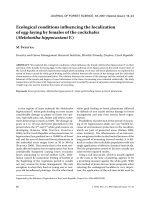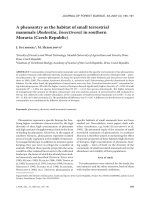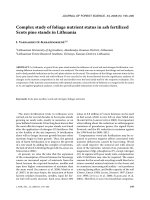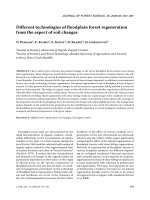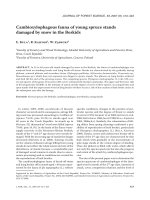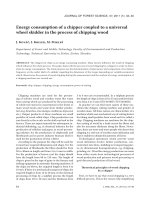Báo cáo lâm nghiệp: "Influence of the fertilisation method in controlled ectomycorrhizal inoculation of two Mediterranean pines" ppt
Bạn đang xem bản rút gọn của tài liệu. Xem và tải ngay bản đầy đủ của tài liệu tại đây (489.57 KB, 7 trang )
Ann. For. Sci. 64 (2007) 577–583 Available online at:
c
INRA, EDP Sciences, 2007 www.afs-journal.org
DOI: 10.1051/forest:2007035
Original article
Influence of the fertilisation method in controlled ectomycorrhizal
inoculation of two Mediterranean pines
Ana R
´
a
*
,JavierP
´
b
,JoanP
b
a
Departamento de Fisiología y Ecología Vegetal, Instituto de Recursos Naturales IRN-CCMA-CSIC, C/ Serrano, 115 dupl, 28006 Madrid, Spain
b
Departament de Protecció Vegetal, Institut de Recerca i Tecnologia Agroalimentaries (IRTA), Centre de Cabrils, Ctra. de Cabrils s/n, 08348 Cabrils
(Barcelona), Spain
(Received 9 September 2006; accepted 20 December 2006)
Abstract – The influence of the fertilisation method: soluble (SF) vs. slow-release fertiliser (SRF) and of inoculation with Laccaria laccata (Scop.)
Fr., Pisolithus tinctorius (Pers.) Coker & Couch and Melanogaster ambiguus (Vittad.) Tul & C. Tul. on ectomycorrhizal colonization and growth of
Pinus pinea L. and Pinus pinaster Ait. was evaluated. For both pines, mycorrhization with L. laccata was not affected by the fertilisation method.
Percentages of ectomycorrhizas (ECM) formed by P. tinctorius were dependent on the fertilisation method, the inoculum type (vegetative or spores)
and the pine species involved. ECM formed by M. ambiguus were increased with fertilisation in both pines. Inoculation significantly improved P. pinea
biomass when seedlings were fertilised with SRF whereas no effect was found in non-fertilised ones. For non-fertilised P. pinaster, inoculation with L.
laccata and both inocula of P. tinctorius increased seedling biomass whereas fertilisation neutralised the fungal effect. Fertilisation increased P. pinea
and P. pinaster biomass, independently of the inoculation treatment.
Pinus pinea / Pinus pinaster / controlled mycorrhization / ectomycorrhizal fungi / seedling nursery production / fertilisation
Résumé – Influence de la méthode de fertilisation sur la mycorhization contrôlée de deux espèces de Pins méditerranéens. L’impact sur le degré
de mycorhization et la croissance de jeunes plants de Pinus pinea L. et de Pinus pinaster Ait., de deux méthodes de fertilisation (fertilisant soluble
(FS) et fertilisant à libération lente) et d’une inoculation contrôlée avec Laccaria laccata (Sco.) Fr., Pisolithus tinctorius (Pers.) Coker et Couch et
Melanogaster ambiguus (Vittad.) Tul et C. Tul. Pour les deux pins, la mycorhization avec Laccaria laccata n’a pas été modifiée par la méthode de
fertilisation. Le pourcentage d’ectomycorrhizes (ECM) formé by P. tinctorius dépendait de la méthode de fertilisation, su type d’inoculum (spores ou
inoculum végétatif) et de l’espèce de pin. La fertilisation a augmenté les ECM produites par Melanogaster ambiguus chez les deux pins. L’inoculation
a augmenté significativement la biomasse des semis de Pinus pinea lorsqu’ils ont été fertilisés avec SRF tandis qu’aucun effet n’a été trouvé pour les
traitements non fertilisés. Pour les semis non fertilisés de Pinus pinaster, l’inoculation avec Laccaria laccata et avec les deux inoculums de Pisolithus
tinctorius a augmenté la biomasse des semis tandis que la fertilisation a neutralisé l’effet de l’inoculation. La fertilisation a augmenté la biomasse de
Pinus pinaster et de Pinus pinea indépendamment du traitement d’inoculation utilisé.
Pinus pinea / Pinus pi naster / mycorhization contrôlée / champignon ectomycorhizien / pépinière de production de semis / fertilisation
1. INTRODUCTION
Fertilisation is a key factor for producing high quality nurs-
ery stock destined to reforestation [17]. An optimal fertilisa-
tion method adjusted to the tree species produced in the nurs-
ery will ensure the improvement of physiological traits such as
growth, nutrient storage, photosynthetic rates and root growth
potential [18]. The application of soluble fertilisers and the
addition of slow-release fertilisers to the potting substrate are
the two fertilisation methods most commonly used in nurs-
eries [3,37]. Soluble fertilisers can be more precisely adjusted
than slow-release ones for each developmental stage of tree
seedlings [28, 30] and they are commonly applied with the
nursery irrigation system. On the other hand, slow-release fer-
tilisers are easier to apply providing an important economical
advantage for producing nursery tree seedlings at a commer-
cial scale. Additionally, the effect of slow-release fertilisers
can persist after outplanting [31].
* Corresponding author:
Spontaneous mycorrhization of seedling commonly occurs
in nursery although usually opportunistic fungi with low host
specificity have been reported [11, 16, 19]. Inoculation with
selected ectomycorrhizal fungi has been often signalled as
a promising practise for improving the quality of nursery
seedling stock [4, 11, 21]. Mycorrhization not only improves
seedling growth and their photosynthetic capacity [12] but
also notably extends the root surface allowing seedlings to a
better exploration of soil after out-planting [36]. Obtaining
a well-developed root system of seedlings in nursery is im-
portant since a vigorous root growth contributes to the abil-
ity of seedlings to overcome post transplanting stress [15].
Mycorrhization can be an important advantage for seedlings
to surmount transplanting stress [7, 36] especially under un-
favourable field conditions such as those imposed by the
Mediterranean climate [25, 34]. When nursery production of
mycorrhizal plants is desired, an adjustment of the fertilisa-
tion regime becomes essential, since high fertilisation inputs
usually inhibit the formation of ectomycorrhizas [4, 14, 35].
Article published by EDP Sciences and available at or />578 A. Rincón et al.
On the other hand, the method of fertilisation used can also
alter the formation of ectomycorrhizas [4,8]. Ectomycorrhizal
fungi have variable nutrient demands for hyphal growth [23]
and their response to fertilisation may be different. This fun-
gal variability must be taken into account before undertaking
a strategy for producing nursery mycorrhizal seedlings of a
determined tree species [19,38].
In this study, we have inoculated two Mediterranean pine
species: Pinus pinea L. and P. pinaster Ait. commonly used for
reforestation in Spain, with two wide-spread coloniser fungi:
Laccaria laccata (Scop.) Fr. and Pisolithus tinctorius (Pers.)
Coker & Couch, highly adapted to common nursery practices
[21, 40], and with Melanogaster ambiguus (Vittad.) Tul & C.
Tul., a good coloniser of P. pinea [32] with proven efficiency
to increase seedling performance under field conditions [27].
We have evaluated the use of two fertilisation methods (soluble
fertiliser and slow-release fertiliser) for producing mycorrhizal
seedlings of both Mediterranean pines. The dosage of nutri-
ents applied with both fertilisation methods was adjusted for
avoiding the inhibition of ectomycorrhizas [25,26,33]. The ob-
jective of this work was to determine the effect of the fertilisa-
tion method and the inoculation with different fungi on mycor-
rhization and growth of containerized P. pinea and P. pinaster
seedlings produced in nursery.
2. MATERIAL AND METHODS
2.1. Plant material
Pinus pinea seeds were collected from natural forests in the Mont-
negre and Montseny sierras in Catalonia (Spain). Pinus pinaster
seeds were obtained from the “Centre National de Recherches
Forestières” (France) origin Valdemoro sierra, Cuenca, Spain. Before
use, seeds were soaked overnight in running tap-water, surface disin-
fected (30 min in 33% H
2
O
2
) and rinsed in distilled water.
2.2. Fungal material and production of fungal
inoculum
Basidiomata of P. tinctorius and M. ambiguus were collected in
mixed forest of P. pinea in different locations of Catalonia (Spain) and
under Pseudotsuga menziesii (Mirb.) Franco plantations in Girona
(Spain), respectively. Collected sporocarps were dried at 35
◦
Cfor
72 h and kept in paper bags until use. Pure cultures of L. laccata
(strain 127, collected under Quercus ilex L.) and P. tinctorius (strain
93, collected under Quercus suber L.) were isolated from fresh sporo-
carp tissue as previously described [32]. Voucher dry basidiomata and
pure cultures were deposited in the herbarium and culture collection
of DPV-IRTA (Barcelona, Spain). Miceliar inocula of L. laccata and
P. tinctorius and spore inocula of P. tinctorius and M. ambiguus were
obtained as previously described [33, 34].
2.3. Inoculations and experimental set-up
A factorial experiment was carried out to test the effect of the fac-
tors: (a) inoculation with ectomycorrhizal fungi (L. laccata, P. tinc-
torius, M. ambiguus, non-inoculated), (b) application of different fer-
Table I. Total amount of nutrients received per seedling with each
fertilization method at the end of the experiment. SF = Soluble fer-
tiliser; SRF = slow release fertiliser.
Nutrient (total mg/seedling)
NPKFeMgMnZnCuBMo
SF 20-7-19 43 15.1 41 4.2 0.8 0.8 0.2 0.2 0.1 0.1
SRF 15-8-11 42 22.5 32 1.2 5.7 0.2 0.04 0.15 0.5 0.5
tilisation methods (soluble fertiliser, slow-release fertiliser, not fer-
tilised) and (c) tree species (P. pinea or P. pinaster), on seedling
growth and ectomycorrhizal development.
A potting substrate containing equal volumes of peat (Floragard,
Oldenburg, Germany) and grade 2 vermiculite (Asfaltex, Barcelona,
Spain), autoclaved (60 min, 120
◦
C) and with a final pH 5.5 (in water)
was used to fill Ray Leach C-10 “Cone-tainers”
TM
(Stuewe & Sons,
Inc., Oregon, USA) containers (165 mL capacity). Vegetative inocu-
lum of either L. laccata or P. tinctorius were mixed with the potting
substrate before filling the containers at the proportion of 1:20 (v:v,
inoculum:substrate). Dried spores of P. tinctorius were mixed with
vermiculite (0.12 g spores in 600 mL vermiculite) and incorporated
into the potting substrate, before filling the containers, at the rate of
10
6
spores per plant. Two surface-disinfected seeds of either P. pinea
or P. pinaster were sown in each container and thinned to one per
container after emergence. Spores of M. ambiguus were inoculated to
one-month-old seedlings as a water suspension to provide 10
6
spores
per seedling.
The soluble fertiliser treatment (SF) consisted of the application
every two weeks of 10 mL/seedling of a solution containing 20-7-
19 Peter’s fertiliser (Scott, Tarragona, Spain) at 1.8 g/L and the mi-
cronutrients preparations Fetrilon
and Hortrilon
(Basf, Barcelona,
Spain) at 0.12 g/L and 0.28 g/L, respectively. The application of sol-
uble fertiliser started one month after seedling germination (May)
and it was stopped six months later at the end of the growing sea-
son (November).
Fertilisation with slow-release fertiliser (SRF) consisted of the ap-
plication of 2.3 g/L substrate of Osmocote Plus
(Scotts, Marysville,
USA) 15-8-11 (totally released after 12 months, at 21
◦
C). Both, SF
and SRF applications were calculated to provide similar amount of
nitrogen along the fertilization period. The total amount of nutrients
received per plant in each fertilisation treatment is shown in Table I.
The dosage of nutrients applied with both fertilisation methods was
adjusted for allowing mycorrhizal development, as it has been proven
in previous studies [25, 26,33].
A total of 15 treatments per pine species were established
with 20 replicates per treatment: (1) not inoculated/not fertilised
(NF), (2) not inoculated/Soluble fertiliser (SF), (3) not inocu-
lated/Slow Release Fertiliser (SRF), (4) L. laccata/NF, (5) L. lac-
cata/SF, (6) L. laccata/SRF, (7) P. tinctorius vegetative inoculum/NF,
(8) P. tinctorius vegetative inoculum/SF, (9) P. tinctorius vegetative
inoculum/SRF, (10) P. tinctorius spores inoculum/NF, (11) P. tinc-
torius spores inoculum/SF, (12) P. tinctorius spores inoculum/SRF,
(13) M. ambiguus/NF, (14) M. ambiguus/SF, (15) M. ambiguus/SRF.
Seedlings were grown in a greenhouse with 16 h photoperiod
(200 µmol s
−1
m
−2
) provided by high pressure sodium vapour lamps.
Greenhouse temperature was between 15–25
◦
C and relative humid-
ity was maintained over 40%.
Controlled mycorrhization of pine seedlings 579
Table II. Summary of the three-way ANOVA (F values) assessing the
effects of inoculation (non-inoculated, Laccaria laccata, Pisolithus
tinctorius miceliar or spores inoculum and Melanogaster ambiguus),
fertilisation (non-fertilised, soluble fertiliser and slow-release fer-
tiliser), pine species (Pinus pinea and Pinus pinaster) and their in-
teractions on seedling growth parameters and ectomycorrhizal short
roots. I = inoculation; F = fertilisation; P = pine species; ECM = ec-
tomycorrhizas; SDW = Shoot dry weight; RDW = root dry weight;
S/R = Shoot/Root ratio. Asterisks: * 0.05 P > 0.01; ** P < 0.001;
ns = non-significant.
ECM Diameter Height SDW RDW S/R
Inoculation 177.9 ** 3.8 * 6.1 ** 5.8 ** 2.2 ns 1.1 ns
Fertilisation 8.1 ** 153.8 ** 268.5 ** 188.4 ** 43.9 ** 137.3 **
Pine 9.3 * 194.2 ** 179.7 ** 205.4 ** 1.7 ns 311.3 **
I × F 3.9 ** 2.6 * 6.8 ** 3.3 * 3.1 * 1.9 ns
I × P 7.9 ** 2.3 ns 2.1 ns 5.5 ** 11.0 ** 8.1 **
F × P 3.7 * 111.2 ** 50.3 ** 33.0 ** 37.6 ** 8.2 **
I × F × P 1.7 ns 3.3 * 3.9 ** 4.5 ** 5.6 ** 2.7 *
R
2
0.82 0.81 0.83 0.78 0.60 0.77
2.4. Measured parameters and statistical analysis
Nine months after sowing, all the seedlings were harvested and
their roots washed free of substrate. The percentage of mycorrhizal
seedlings was determined in each treatment. Ectomycorrhizal short
roots (ECM) were identified according to morphological criteria as
previously described [32–34]. Each seedling root was cut in 2–3 cm
segments, and the percentage of ECM assessed by counting at least
200 randomly selected short roots under the stereomicroscope. All
plants were measured for stem height and root collar diameter. The
seedlings shoots and roots were oven dried (60
◦
C, 72 h) to obtain the
dry weights.
The proportion of mycorrhizal seedlings for each fertilisation
treatment and tree species were analysed by contingency tables
with the SPSS 11.0 Software Package. Mycorrhizal colonisation
and growth data were analysed by multifactor-ANOVA. Percent-
ages of ectomycorrhizas were arc-sin transformed before performing
ANOVA. When interactions were detected, data were analysed sep-
arately for each factor by one-way ANOVA. Significant differences
among treatments were detected by Tukey’s test (P < 0.05).
3. RESULTS
3.1. Mycorrhization
The percentage of ectomycorrhizas was significantly af-
fected by inoculation, fertilisation and the pine species
(Tab. II). Interactions between all factors were found and the
ANOVA was performed separately for each factor.
The inoculum of L. laccata was effective forming ectomy-
corrhizas (ECM) with almost all plants of both pine species
(Figs. 1A and 1B). The percentage of ECM obtained with this
fungus on P. pinea was under 50% in any treatment, while on
P. pinaster it was slightly higher (Figs. 2A and 2B). For both
pines, mycorrhization with L. laccata was not affected by the
fertilisation method.
0
25
50
75
100
L. laccata P. tinctorius
Vi
P. tinctorius
Spo
M. ambiguus
Mycorrhizal seedlings (%)
Non-fertilised Soluble fertiliser Slow-release fertiliser
b
a
ab
a
a
a
a
a
a
a
a
a
(B)
(A)
0
25
50
75
100
L. laccata P. tinctorius
Vi
P. tinctorius
Spo
M. ambiguus
Mycorrhizal seedlings (%)
Non-fertilised Soluble fertiliser Slow-release fertiliser
aa
ab
b
a
ab
a
b
a
aa
a
Figure 1. Percentages of mycorrhizal seedlings of P. pinea (A) and
P. pinaster (B) inoculated with three ectomycorrhizal fungi under dif-
ferent fertilisation regimes. Different letters in each inoculation treat-
ment denote significant differences among fertilisation treatments
analysed by contingency tables (P 0.05). Vi = vegetative inocu-
lum; Spo = spores inoculum.
The application of vegetative inoculum of P. tinctorius
produced less than 30% of colonised seedlings in both pine
species (Figs. 1A and 1B). The percentage of ECM ob-
tained with vegetative inoculum of this fungus on P. pinea
seedlings was significantly increased by fertilisation with sol-
uble fertiliser (SF) (Fig. 2A). Colonised P. pinaster seedlings
showed more than 75% of ECM and mycorrhizal colonisation
was independent of the fertilisation method used (Fig. 2B).
Pisolithus tinctorius applied as spore inoculum was more ef-
fective for the mycorrhization of P. pinaster than for P. pinea
(Figs. 1 and 2). For both conifers, rates of mycorrhizal
seedlings obtained with this fungus were reduced when SF
was applied (Figs. 1A and 1B). The percentage of ECM
of P. pinea seedlings inoculated with spores of P. tincto-
rius was unaffected by the fertilisation method (Fig. 2A).
On the other hand, a significant increase of ECM formed
by this fungus was observed on not fertilised P. pinaster
seedlings (Fig. 2B). The percentage of P. pinea seedlings
mycorrhizal with M. ambiguus was reduced by fertilisation
with SF (Fig. 1A). Contrarily, the proportion of P. pinaster
seedlings colonized with this fungus was increased with both
fertilisation methods (Fig. 1B). The percentage of ECM of
M. ambiguus was slightly increased with fertilisation in both
580 A. Rincón et al.
(B)
(A)
0
25
50
75
100
L. laccata P. tinctorius
Vi
P. tinctorius
Spo
M. ambiguus
Ectomycorrhizal short roots (%)
Non- fertilised Soluble fertiliser Slow-release fertiliser
a
a
a
a
a
b
aa
a
a
a
b
0
25
50
75
100
L. laccata P. tinctorius
Vi
P. tinctorius
Spo
M. ambiguus
Ectomycorrhizal short roots (%)
Non- fertilised Soluble fertiliser Slow-release fertiliser
a
a
a
a
a
a
a
a
b
a
a
a
Figure 2. Percentages of ectomycorrhizas on P. pinea (A) and
P. pinaster (B) seedlings inoculated with three ectomycorrhizal fungi
under different fertilisation regimes. Different letters in each inoc-
ulation treatment denote significant differences among fertilisation
treatments by ANOVA according to Tukey’ test (P 0.05). Vi =
vegetative inoculum; Spo = spores inoculum.
pines (Figs. 2A and 2B), but significant differences were only
found between P. pinea seedlings not fertilised and fertilised
with SRF (Fig. 2A).
3.2. Seedling growth
In general, the studied factors significantly influenced the
growth of seedlings (Tab. II). Significant interactions among
factors were found for all parameters, and statistics were car-
ried out separately for each factor by one-way ANOVA.
3.2.1. Effect of inoculation
Fungal inoculation did not affect the growth of P. pinea
seedlings when they were not fertilised (NF), with excep-
tion of L. laccata which significantly stimulated the root dry
weight (Tab. III). When soluble fertiliser (SF) was applied,
only seedlings inoculated with vegetative inoculum of P. tinc-
torius had a significant increase in shoot dry weight compared
with non inoculated seedlings. When P. pinea was grown with
slow-release fertiliser (SRF), inoculation with both inocula
of P. tinctorius significantly improved diameter and height
of seedlings, and inoculation with all the fungi tested signif-
icantly increased seedling biomass (Tab. III). A variable effect
of inoculation on seedlings growth was obtained for P. pinaster
in all fertilisation treatments (Tab. IV). A growth enhance-
ment was found in seedlings NF and inoculated with L. lac-
cata (height and shoot dry weight) and with the two inocula of
P. tinctorius (shoot and root dry weight) (Tab. IV). When each
of SF and SRF was applied, inoculation did not significantly
improved P. pinaster biomass (Tab. IV).
3.2.2. Effect of the fertilisation method
The height of P. pinea seedling was, in general, increased
by fertilisation irrespectively of the method used, whereas for
the diameter a variable effect was obtained (Tab. III). Fertilisa-
tion increased P. pinea shoot dry weight in any of the inocula-
tion treatments except for non-inoculated seedlings and those
inoculated with L. laccata and fertilised with SRF (Tab. III).
On the other hand, fertilisation with each method signif-
icantly increased the growth of P. pinaster seedlings, irre-
spective of the inoculation treatment (Tab. IV). For both pine
species, the shoot/root ratio was significantly improved by fer-
tilisation in all inoculation treatments, irrespectively of the fer-
tilisation method used (Tabs. III and IV).
4. DISCUSSION
Laccaria laccata effectively colonised almost all seedlings
and the formation of ECM was not affected by the fertilisation
method. Similar results have been previously reported for this
fungus in association with P. pinea and P. pinaster [26, 32]. It
has been suggested that the mycorrhizal ability of this fungus
is not affected by the fertilisation method used, but it mostly
depends on the associated tree species [9].
Vegetative inoculum of P. tinctorius was poorly effective,
producing low number of mycorrhizal seedlings of both pines.
Percentage of ECM varied with the fertilisation method for
P. pinea, whereas no differences were found for P. pinaster.
Vegetative inoculum of P. tinctorius has been previously used
for inoculating diverse conifer species in nursery in several
countries [20, 21].The low number of mycorrhizal plants ob-
tained in our experiment could be due to a poorly matured
inoculum with not sufficient fungal active propagules. When
P. tinctorius was applied as spores, it was more effective for
the mycorrhization of P. pinaster than for P. pinea. Mycor-
rhization was reduced on fertilised pines, mainly when soluble
fertiliser was applied, probably indicating this factor as affect-
ing fungal spores viability. Spore inoculum of P. tinctorius has
been previously tested in P. pinea and P. pinaster inoculations
with higher mycorrhization rates than those obtained in our
experiment [26, 32]. Our results suggest that the experimen-
tal conditions could have affected spore germination. A better
knowledge of the factors regulating spore germination is re-
quired to improve both the speed and stability of mycorrhizal
formation with this type of inoculum [5].
Controlled mycorrhization of pine seedlings 581
Table III. Effect of the inoculation with different ectomycorrhizal fungi and of the fertilisation method on growth of containerised Pinus pinea
seedlings. For each fertilisation treatment, different minor letters in each column denote significant differences among inoculation treatments ac-
cording to Tukey’ test (P < 0.05). For an equal inoculation treatment, capital etters denote differences among fertilisation treatments according
to Tukey’ test (P < 0.05). Vi = vegetative inoculum; Spo = spores inoculum.
Tab le IV. Effect of the inoculation with different ectomycorrhizal fungi and of the fertilisation method on growth of containerised Pinus pinaster
seedlings. For each fertilisation treatment, different minor letters in each column denote significant differences among inoculation treatments
according to Tukey’ test (P < 0.05). For an equal inoculation treatment, capital letters denote differences among fertilisation treatments
according to Tukey’ test (P < 0.05). Vi = vegetative inoculum; Spo = spores inoculum;
582 A. Rincón et al.
Spore inoculum of M. ambiguus was effective for obtain-
ing mycorrhizal seedlings of both pines. The highest ECM
percentages were obtained in the fertilisation treatments, in-
dependently of the fertilisation method used. Spore inoculum
of M. ambiguus has been previously used for inoculation of
containerised conifers [24, 32]. The improvement of M. am-
biguus mycorrhization ability by fertilisation could indicate a
different foraging strategy of this fungus with higher nutrient
demands for hyphal development compared with the rest of
fungi tested in our study. In general, average mycorrhizal col-
onization levels were slightly higher on P. pinaster seedlings
than on P. pinea. These differences agree with previous studies
reporting a variable response of different tree species to fungal
colonisation by a given fungus [22, 38].
Seedling growth was dependent on the three factors stud-
ied: (1) inoculation, (2) fertilisation and (3) pine species. It is
remarkable that when P. pinea seedlings were fertilised with
SRF, a significant increase on seedling biomass due to inocu-
lation with the different fungi was observed. The nutrient lev-
els supplied with this fertilisation method seemed to be opti-
mal for impairing mycorrhizal inoculum function in the rhi-
zosphere of P. pinea. Gradual and progressive nutrient enrich-
ment of the substrate with slow-release fertiliser could enable
the fungal mycelium to develop tolerance mechanisms to nu-
trient accumulation [41]. Contrary to P. pinea, a significant
effect of inoculation on P. pinaster biomass was only achieved
when seedlings were not fertilised, whereas fertilisation neu-
tralised the fungal effect independently of the method used.
Different fungal species can differ in their tolerance to dif-
ferent fertilisation methods [2, 40]. Nevertheless, since the to-
tal inorganic nutrient demand for hyphal growth in pots rela-
tive to that of the plant is very small, the variable fungal effect
under the same fertilisation treatments could be mostly depen-
dent on the nutrient demand of the tree host.
Both, P. pinea and P. pinaster, grew better when fertilised,
independently of the method used, and in general, P. pinaster
was more dependent on fertilisation than P. pinea. Complexes
environmental variables can be interconnected with seedling
nutrient requirements, as demonstrated for P. pinaster and its
demand of phosphorous being dependent on light availability
[10]. The fertilisation methods (SF and SRF) at the dosage
used were adequate for obtaining good morphological stan-
dards of seedling quality for both pine species.
The application of mycorrhizal inoculation in nursery, even
if it does not necessarily mean an increase in seedling growth,
has often demonstrated to allow a better survival of seedlings
in the field [6,7]. This is especially important under harsh cli-
matic conditions such as those imposed by the Mediterranean
climate [1, 25,29]. Nursery mycorrhization can be an advan-
tage for seedlings to surmount the transplanting stress, since it
confers additional protection to roots against desiccation and
aids seedlings to exploring a greater volume of soil for nutrient
acquisition [13, 36]. On the other hand, a high fertilisation of
seedlings in nursery does not necessarily offer a guarantee of
survival after planting, since it usually causes an unbalanced
shoot/root ratio [18, 39]. Thus, it would be highly desirable
to conciliate both practises: fertilisation and inoculation with
selected fungi, to minimise nursery fertilisation inputs and to
assure physiological quality of seedlings and root protection
by the formation of ectomycorrhizas with selected fungi.
In our work, the fertilisation method significantly affected
the proportion and the colonisation extent of pine seedlings
inoculated with different ectomycorrhizal fungi. Also, the
growth effects were dependent on the fertilisation method and
the fungal species inoculated. Therefore, matching selected
fungi with the appropriate growth conditions is necessary for
producing quality seedlings for commercial purposes [5].
Acknowledgements: This work was supported by the European
Commission Contract AIR2-CT94-1149. The first author was granted
(94/97 FPI programme) by the Ministerio de Educación y Ciencia,
Spain.
REFERENCES
[1] Argillier C., Falconnet G., Tillard P., Mousain D., Essais
d’introduction dans un arénosol calcaire de Petite-amargue de pins
pignons (Pinus pinea L.) mycorhizés par Suillus collinitus,Rev.For.
Fr. XLIX (1997) 131–140.
[2] Arnebrant K., Nitrogen amendments reduce the growth of extramat-
ical mycelium, Mycorrhiza 5 (1994) 7–15.
[3] Brix H., van der Driessche R., Mineral nutrition of container-grown
tree seedlings, in: Proc. of North Am. Cont. Tree Seedling Symp.,
Denver CO, Tinus R.W., Stein W.I., Balmer W.E. (Eds.), Great
Plains Agriculture Concil, Publ. No. 68, 1974, pp. 77–84.
[4] Brundrett M., Bougher N., Dell B., Grove T., Malajczuk N.,
Working with mycorrhizas in forestry and agriculture, ACIAR
Monograph 32, Camberra, Australia, 1996.
[5] Brundrett M., Malajczuk N., Mingqin G., Daping X., Snelling S.,
Dell B., Nursery inoculation of Eucalyptus seedlings in Western
Australia and Southern China using spores and mycelial inoculum
of diverse ectomycorrhizal fungi from different climatic regions,
For. Ecol. Manage. 209 (2005) 193–205.
[6] Castellano M.A., Current status of outplanting studies using
ectomycorrhiza-inoculated forest trees, in: Pfleger F.L., Linderman
R.G. (Eds.), Mycorrhizas and plant health, APS Press, St. Paul, MN,
1994, pp. 261–281.
[7] Castellano M. A., Out-planting performance of mycorrhizal inoc-
ulated seedlings, in: Mukergi K.G. (Ed.), Concepts in Mycorrhizal
Research, Kluwer Ac. Publ. (1996) 223–301.
[8] Castellano M.A., Trappe J.M., Molina R., Inoculation of container-
grown Douglas-fir seedlings with basidiospores of Rhizopogon vini-
color and R. colossus:effects of fertility and spore application rate,
Can. J. For. Res. 15 (1985) 10–13.
[9] Chakravaty P., Chatarpaul L., Effect of fertilisation of seedling
growth, ectomycorrhizal symbiosis and nutrient uptake in Larix lar-
icina, Can. J. For. Res. 20 (1990) 245–248.
[10] Cheaïb A., Mollier A., Thunot S., Lambrot C., Pellerin S., Loustau
D., Interactive effects of phosphorous and light availability on early
growth of maritime pine seedlings, Ann. For. Sci. 62 (2005) 575–
583.
[11] Cordell C.E., Owen J.H., Marx D.H., Mycorrhizae nursery manage-
ment for improved seedling quality and field performance. Meeting
the challenge of the nineties, Proc. Intermount. For. Nursery Assoc.
Oklahoma City, Okla, GTR-RM-151, 1987, pp. 105–115.
[12] Dosskey M.G., Boersma L., Linderman R.G., Role for the pho-
tosynthate demand of ectomycorrhizas in response of Douglas-fir
seedlings to drying soil, New Phytol. 117 (1991) 327–334.
[13] Garbaye J., The role of ectomycorrhizal symbiosis in the resistance
of forests to water stress, Outlook on Agriculture 29 (2000) 63–69.
Controlled mycorrhization of pine seedlings 583
[14] Gagnon J., Langlois C.G., Bouchard D., Le Tacon F., Growth
and ectomycorrhizal formation of container-grown Douglas-fir
seedlings inoculated with Laccaria bicolor under four levels of ni-
trogen fertilisation, Can. J. For. Res. 25 (1995) 1953–1961.
[15] Grossnickle S.C., Importance of root growth in overcoming plant-
ing stress, New For. 30 (2005) 273–294.
[16] Iwanski M., Rudawska M., Leski T., Mycorrhizal association of
nursery grown Scots pine (Pinus sylvestris L.) seedlings in Poland,
Ann. For. Sci. 63 (2006) 715–723.
[17] Jacobs D.F., Timmer V.R., Fertiliser-induced changes in rhizo-
sphere electrical conductiviy: relation to forest tree seedling root
system growth and function, New For. 30 (2005) 147–166.
[18] Landis T. D., The container tree nursery manual, Vol. 4, Landis
T.D., Tinus R.W., McDonald S.E., Barnett J.P. (Eds.) Agric.
Handbk. 647. Washington, DC, USDA For. Serv. Res., 1989.
[19] Marx D.H., Ectomycorrhizal fungus inoculation: a tool for improv-
ing forestation practices, in: Mikola P. (Ed.), Tropical mycorrhiza
research, Oxford Univ Press, New York, 1980, pp. 13–71.
[20] Marx D.H., Variability in ectomycorrhizal development and growth
among isolates of Pisolithus tinctorius as affected by source, age
and reisolation, Can. J. For. Sci. 11 (1981) 168–174.
[21] Marx D.H., Ruehle J.L., Cordell C.E., Methods for studying nurs-
ery and field responses of tree to specific ectomycorrhiza, Meth.
Microbiol. 23, 1991, pp. 382–411.
[22] Molina R., Massicotte H., Trappe J.M., Specificity phenomena in
mycorrhizal symbiosis: community-ecological consequences and
practical implications, in: Allen M.F. (Ed.), Mycorrhizal function-
ing, Chapman & Hall, New York, 1992, pp. 357–423.
[23] Olsson P.A., Jakobsen I., Wallander H., Foraging and resource al-
location strategies of mycorrhizal fungi in a patchy environment,
in: Van der Heijden, M.G.A., Sanders I.R. (Eds.), Mycorrhizal
Ecology, Springer-Verlag, Berlin, Heidelberg, 2002, pp. 93–115.
[24] Parladé J., Álvarez I.F., Pera J., Ability of native ectomycorrhizal
fungi from northern Spain to colonise Douglas-fir and other intro-
duced conifers, Mycorrhiza 6 (1996) 51–55.
[25] Parladé J., Luque J., Pera J., Rincón A., Field performance of Pinus
pinea and P. halepensis seedlings inoculated with Rhizopogon spp.
and out-planted in formerly arable land, Ann. For. Sci. 61 (2004)
507–514.
[26] Pera J., Álvarez I.F., Ectomycorrhizal fungi of Pinus pinaster,
Mycorrhiza 5 (1995) 193–200.
[27] Pera J., Álvarez I.F., Rincón A., Parladé J., Field performance in
northern Spain of Douglas-fir seedlings inoculated with ectomycor-
rhizal fungi, Mycorrhiza 9 (1999) 77–84.
[28] Qu L., Quoreshi A.M., Koike T., Root growth characteristics,
biomass and nutrient dynamics of seedlings of two larch species
raised under different fertilisation regimes, Plant Soil 255 (2003)
293–302.
[29] Querejeta J.I., Roldán A., Albadalejo J., Castillo V., The role of my-
corrhizae, site preparation, and organic amendment in the afforesta-
tion of a semi-arid Mediterranean site with Pinus halepensis,For.
Sci. 44 (1998) 203–211.
[30] Quoreshi A.M., Timmer V.R., Exponential fertilisation increases
nutrient uptake and ectomycorrhizal development of black spruce
seedlings, Can. J. For. Res. 28 (1998) 674–682.
[31] Reddell P., Webb M.J., Poa D., Aihuna D., Incorporation of slow-
release fertilisers into the nursery media, New For. 18 (1999) 277–
287.
[32] Rincón A., Álvarez I.F., Pera J., Ectomycorrhizal fungi of Pinus
pinea L. in northeastern Spain, Mycorrhiza 8 (1999) 271–276.
[33] Rincón A., Álvarez I.F., Pera J., Inoculation of containerised Pinus
pinea L. seedlings with seven ectomycorrhizal fungi, Mycorrhiza
11 (2001) 265–271.
[34] Rincón A., Parladé J., Pera J., Effects of ectomycorrhizal inocula-
tion and the type of substrate on mycorrhization, growth and nutri-
tion of containerised Pinus pinea L. seedlings produced in a com-
mercial nursery, Ann. For. Sci. 62 (2005) 1–6.
[35] Shaw C.G.III., Molina R., Walden J., Development of ectomycor-
rhizae following inoculation of containerised Stika and white spruce
seedlings, Can. J. For. Res. 12 (1982) 191–195.
[36] Smith S.E., Read D.J., Mycorrhizal Symbiosis, Academic Press,
Cambridge, 1997.
[37] Tinus R.W., McDonald S.E., How to grow tree seedlings in con-
tainers in greenhouses, USDA, For. Serv. Res. General Technical
Report RM-60, 1979, 265 p.
[38] Trappe J.M., Selection of fungi for ectomycorrhizal inoculation in
nurseries, Ann. Rev. Phytopathol. 15 (1977) 203–222.
[39] Van den Driessche R, Changes in drought resistance and root
growth capacity of container seedlings in response to nursery
drought, nitrogen and potassium, Can. J. For. Res. 22 (1992) 740–
749.
[40] Wallander H., A new hypothesis to explain allocation of dry matter
between mycorrhizal fungi and pine seedlings in relation to nutrient
supply, Plant Soil 168 (1995) 243–248.
[41] Wallander H., Nylund J E., Effects of excess of nitrogen and phos-
phorous starvation on the extramatical mycelium of Pinus sylvestris
L. ectomycorrhiza, New Phytol. 120 (1992) 495–503.
